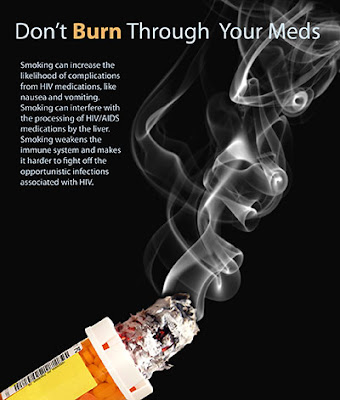By: Ranier Simons, ADAP Blog Guest Contributor
The advent of combination antiretroviral therapy (ART) has greatly improved the lives of people living with HIV/AIDS (PLWHA). ART has reduced HIV infection related morbidity and mortality overall and reduced the rates of AIDS defining cancers.[1] AIDS defining cancers are those that PLWHA are at a high risk for developing. When they develop these cancers, it usually means they have advanced from HIV to AIDS. Kaposi sarcoma, certain types of non-Hodgkin lymphoma, and cervical cancer are examples of AIDS-defining cancers.[2] In contrast to ART’s reduction of AIDS-defining cancers, while the risk is decreasing, the incidence of non-AIDS-defining cancers remains.[2] Non-AIDS-defining cancers are those that are more likely to appear in HIV-positive people. Lung cancer is the non-AIDS-defining cancer that appears the most. A recent study indicates that PLWHA remains at a higher risk and incidence of lung cancer compared to the population at large.[3]
 |
| Photo Source: pratidintime.com |
The study does not fully explain the causality of the higher incidence, however it does shed more light onto what is occurring. The U.S. National Cancer Institute performed a population-based registry linkage study using 2001–2016 data from the HIV/AIDS Cancer Match study, which links data from HIV and cancer registries from 13 regions in the USA.[4] There were 4,310,304 subjects followed in the study. During the study span 3,426 developed lung cancer. Compared to the general population, the data showed that PLWHA in their 40’s have twice the risk of developing lung cancer, PLWHA in their 50’s were 61% more likely, and PLWHA in their 60’s were 30% more likely to develop lung cancer.[3] It also noted that lung cancer surpasses Kaposi’s Sarcoma and Hodgkin’s Lymphoma as the leading cancer in PLWHA over the age of 50. That is a notable distinction given that Kaposi’s Sarcoma and Hodgkin’s Lymphoma are AIDS-defining cancers.
One factor contributing to the increased lung cancer incidence is smoking. Tobacco smoking rates are much higher among PLWHA than the general population.[5] There is evidence-based consensus that the lungs of PLWHA are especially susceptible to the harmful effects of cigarette smoke.[6] Additionally, due to HIV infection, their bodies are already in a constant state of inflammation. Cigarette smoking does not completely explain the higher lung cancer risk. Immunosuppression is also a factor. Although ART is very effective, there is still some immunosuppression due to HIV infection. By 2013-2016, half the study population had been living with HIV for at least ten years.[7] Researchers also found that the prognosis was worse and risk high for PLWHA who at any point previously had an AIDS diagnosis.[3]
 |
| Photo Source: DCTCF |
Medical research is continuing to investigate the etiology of lung cancer in PLWHA. Meanwhile, prevention is paramount. Most early lung cancer is asymptomatic. Thus, discovering cases early through screening before symptoms are seen will result in better outcomes. For some types of lung cancer, the survival rate is around 90% when tumors are discovered while small.[3] In the U.S., screening of adults with a smoking history, aged 50-80, is already recommended. The growing consensus is that screening of PLWHA needs to start earlier. Moreover, HIV status should be considered for inclusion in the entry criteria for lung cancer screening programs.[8]
[1] Moltó, J., Moran, T., Sirera, G., & Clotet, B. (2015). Lung cancer in HIV-infected patients in the combination antiretroviral treatment era. Translational Lung Cancer Research, 4(6), 678-688. doi:10.3978/j.issn.2218-6751.2015.08.10
[2] Cedars Sinai. (2022). AIDS-Related Cancers. Retrieved from https://www.cedars-sinai.org/health-library/diseases-and-conditions/a/aids-related-cancers.html
[3] Hudson, D. (2022, October 16). People with HIV are at twice the risk of lung cancer, study finds. Retrieved from https://www.queerty.com/people-hiv-twice-risk-lung-cancer-study-finds-20221016#.Y2J6PmVsaPA.twitter
[4] Engels, A. et al. (2022). Trends and risk of lung cancer among people living with HIV in the USA: a population-based registry linkage study. Lancent HIV, 9(10), 700-708. https://doi.org/10.1016/S2352-3018(22)00219-3
[5] Centers for Disease Control. (2022). People Living with HIV. Retrieved from https://www.cdc.gov/tobacco/campaign/tips/groups/hiv.html
[6] Rahmanian, S. et al. (2011). Cigarette smoking in the HIV-infected population. Proceedings of the American Thoracic Society, 8(3), 313-319. https://doi.org/10.1513/pats.201009-058WR
[7] Alcorn, K. (2022, October 11). Risk of lung cancer is higher for people with HIV. Retrieved from https://www.aidsmap.com/news/oct-2022/risk-lung-cancer-higher-people-hiv
[8] Hein, I. (2022, October 6). Lung cancer declining in people with HIV, but still high. Retrieved from https://www.medpagetoday.com/hivaids/hivaids/101100
Disclaimer: Guest blogs do not necessarily reflect the views of the ADAP Advocacy Association, but rather they provide a neutral platform whereby the author serves to promote open, honest discussion about public health-related issues and updates.

No comments:
Post a Comment